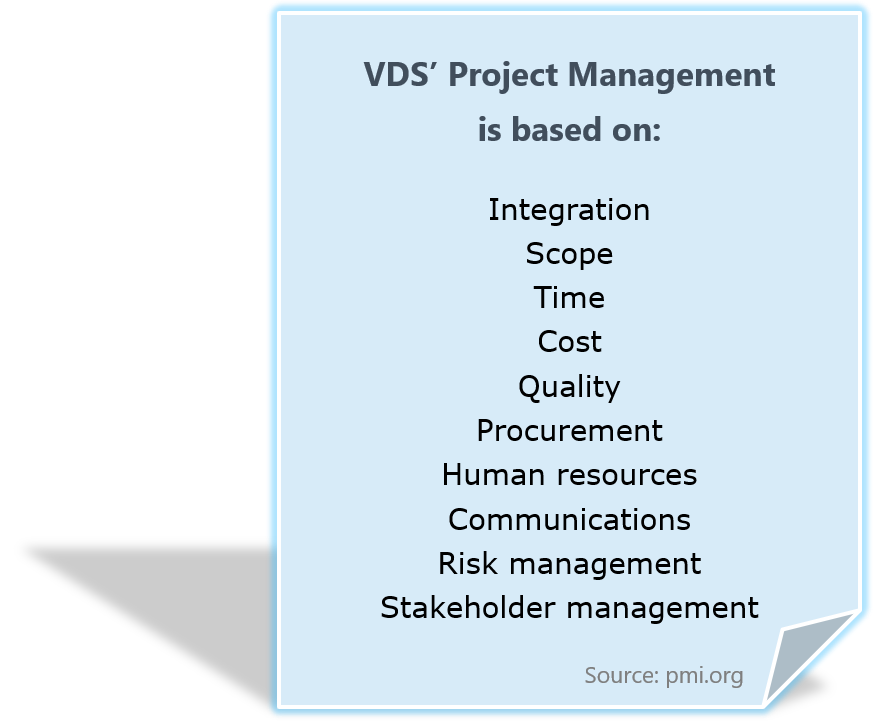Project Management
VDS operates on the principle “Get the Right person for the right job, at the right time”, as the ancient (in 1st Century BCE) Tamil scholarThiruvalluvar wrote “Idhanai Idhanaal Ivan Mudikkum Endraaindhu, Adhanai Avankan Vidal”, which translates as “Identify the right person at the right place at the right time for the right purpose”.
At VDS we clearly understand that a project is temporary (has a defined beginning and end in time), and that every project is unique in that it is not a routine operation, but a specific set of operations designed to accomplish a singular goal. We also understand that a project team often includes people who don’t usually work together – sometimes from different organizations and across multiple geographies. We further have the clear understanding that every project must be expertly managed to deliver the on-time, on-budget results, learning and integration specific to the organization we deal with.
Our Project management strategy is to apply this knowledge, skills, tools, and techniques to project activities to meet the project requirements. VDS’ collective experience brings a unique focus shaped by the goals, resources and schedule of each project. A successful project is the result of stakeholder commitment, meticulous planning, implementation and constant control.

PMI’s A Guide to the Project Management Body of Knowledge (PMBOK® Guide) identifies its recurring elements:
Project management processes fall into five groups:
- Initiating
- Planning
- Executing
- Monitoring and Controlling
- Closing
Project management knowledge draws on ten areas:

Agile Application Lifecycle Management
Traditional ALM is often governed by steps for completing the product. First you gather requirements. Then you build the product. And then you run tests. This can create silos by process, and does not in the modern fast-paced IT environment.
VDS understands these shortcomings, and adopts Agile ALM, which favors cross-functional team interaction. Gathering requirements is a collaborative process — and these requirements are reviewed and updated constantly. The product is built and tested in sprints, facilitating greater collaboration throughout the process.
Working Software Over Comprehensive Documentation.
ALM is traditionally characterized by extensive documentation. VDS suggests prioritizing fast (quality) releases over documentation. From our past experiences, we believe Hybrid Agile typically bridges the gap for organizations who need the documentation (e.g., for compliance) but want to be Agile.
Customer Collaboration Over Contract Negotiation.
To VDS, customer feedback is critical. It’s often included in requirements gathering throughout the development lifecycle.
Responding to Change Over Following a Plan.
Agile ALM responds to change. VDS understands, “the plan” — if you call it that — is in flux. This helps team members be more agile and productive and deliver the right functionality at the right time. With our years of experience in living this, we recognize this typically helps you minimize the costs.
Going From Theory to Practice
VDS understands that Agile is straightforward in theory, but it takes work to implement Agile processes. Experience teaches that trying to switch to Agile too quickly can be disorienting for some team members, and makes organizational Agile adoption difficult. But giving up on Agile is not an option because of its various advantages. Teams will get more comfortable with Agile processes as you go along. Transitioning to hybrid Agile can pave the way for a smoother adoption. This means practicing Agile for some parts of development, but using non-Agile techniques for other parts.
Agile Issue Tracking
VDS handles Agile issue tracking by inviting a collaboration to resolve issues. When an issue comes in, it is prioritized based on impact. A team works through this backlog of issues, resolving issues as quickly as they can.
Run Agile Tests
VDS understands that Agile testing happens continuously. Test cases are set based on user stories. As new user stories are added, new test cases should be added too. Testing is done in sprints, often utilizing test automation to increase test coverage. Most importantly, test plans are constantly reviewed and changed to meet changing needs.
